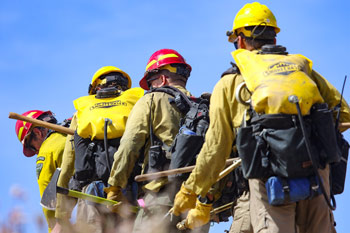Click Here for California Fires
July 23, 2024 - As of this morning, 69 large active wildfires are being managed and have burned 1,291,253 acres. Fire managers are using full suppression strategies on 62  of these wildfires. The Durkee Fire in Oregon displayed extreme fire behavior yesterday and gained more than 62,000 acres. Many wildfires in the Northwest area continue to have active to extreme fire behavior, with evacuation orders in effect on 15 fires. Evacuation orders are also in effect for several fires in California, the Northern Rockies and the Great Basin. If you live in an area that has been evacuated, please follow the instructions from local authorities. They will provide the latest recommendations based on the threat to your community and appropriate safety measures.
of these wildfires. The Durkee Fire in Oregon displayed extreme fire behavior yesterday and gained more than 62,000 acres. Many wildfires in the Northwest area continue to have active to extreme fire behavior, with evacuation orders in effect on 15 fires. Evacuation orders are also in effect for several fires in California, the Northern Rockies and the Great Basin. If you live in an area that has been evacuated, please follow the instructions from local authorities. They will provide the latest recommendations based on the threat to your community and appropriate safety measures.
Nearly 21,500 wildland firefighters are assigned to wildfires nationwide, including 22 complex and 5 Type 1 incident management teams, more than 510 crews, 1,274 engines, numerous aviation resources, and four modular Modular Airborne Fire Fighting Systems, or MAFFS.
The Great Basin Coordination Center's predictive services staff have issued three fuels and fire behavior advisories for Nevada, Southern Idaho and Utah and Arizona Strip. There is also a fuels and fire behavior advisory in effect for California. Residents, travelers, or workers on their way to any of these states should be advised and familiarize themselves with the elevated risks.
The national predictive services staff at the National Interagency Coordination Center released the National Significant Wildland Fire Potential Outlook for July through October. For additional information about the current outlook visit the Outlook page on the NICC site.
If you live near where a wildfire is burning, it's important to stay aware of local fire conditions and, if needed, be prepared to leave at a moment's notice. If you are told to evacuate, go promptly. If at any time you feel unsafe, don't wait for an evacuation order—leave immediately. Planning, preparing and following evacuation orders can help make leaving quicker, easier and safer for residents and first responders.
Hot temperatures with low afternoon relative humidity will continue today across eastern Oregon, the northern and western Great Basin, northern California, and northern Rockies, but temperatures will cool in Washington behind a dry cold front. West-northwest winds will develop along and east of the Cascades and into the Idaho Panhandle as the ridge continues to flatten, with gusty and dry downslope winds are expected in north-central Montana ahead of the cold front. Moisture will be slightly more limited in the northern Great Basin this afternoon, with very isolated mainly dry thunderstorms possible in far northwest Nevada into southeast Oregon, central Idaho, northwest Wyoming, and southwest Montana. Moisture from the monsoon is expected to move northward overnight and interact with cold front over southwest and central Idaho after midnight tonight with isolated dry thunderstorms likely to develop. Isolated to scattered wet thunderstorms are likely farther south along the eastern Sierra into the central and southern Great Basin, Colorado, and Southwest. Widespread showers and thunderstorms will develop along a stalled front from central and south Texas to the Mid-Atlantic coast, with scattered showers and thunderstorms across much of the Midwest and Northeast as well. Alaska will continue to be hot and dry today, with isolated thunderstorms possible over southeast Alaska.
| Number of new large fires or emergency response * New fires are identified with an asterisk |
11 | States currently reporting large fires: |
| Number of active large fires Total does not include individual fires within complexes. |
69 | |
| Acres from active fires | 920,817 | |
| Fires contained | 3 |
Year-to-date statistics
| 2024 (1/1/24-7/23/24) | Fires: 26,468 | Acres: 3,498,035 |
| 2023 (1/1/23-7/23/23) | Fires: 28,470 | Acres: 847,349 |
| 2022 (1/1/22-7/23/22) | Fires: 35,681 | Acres: 5,559,857 |
| 2021 (1/1/21-7/23/21) | Fires: 36,172 | Acres: 2,697,108 |
| 2020 (1/1/20-7/23/20) | Fires: 29,983 | Acres: 1,903,169 |
| 2019 (1/1/19-7/23/19) | Fires: 24,269 | Acres: 2,611,189 |
| 2018 (1/1/18-7/23/18) | Fires: 35,839 | Acres: 3,938,328 |
| 2017 (1/1/17-7/23/17) | Fires: 36,217 | Acres: 4,979,862 |
| 2016 (1/1/16-7/23/16) | Fires: 31,579 | Acres: 2,950,754 |
| 2015 (1/1/15-7/23/15) | Fires: 33,803 | Acres: 5,531,366 |
| 2014 (1/1/14-7/23/14) | Fires: 31,081 | Acres: 1,581,995 |
10-year average Year-to-Date
| 2014-2023 | Fires: 32,318 | Acres: 3,204,899 |
Source: NIFC








